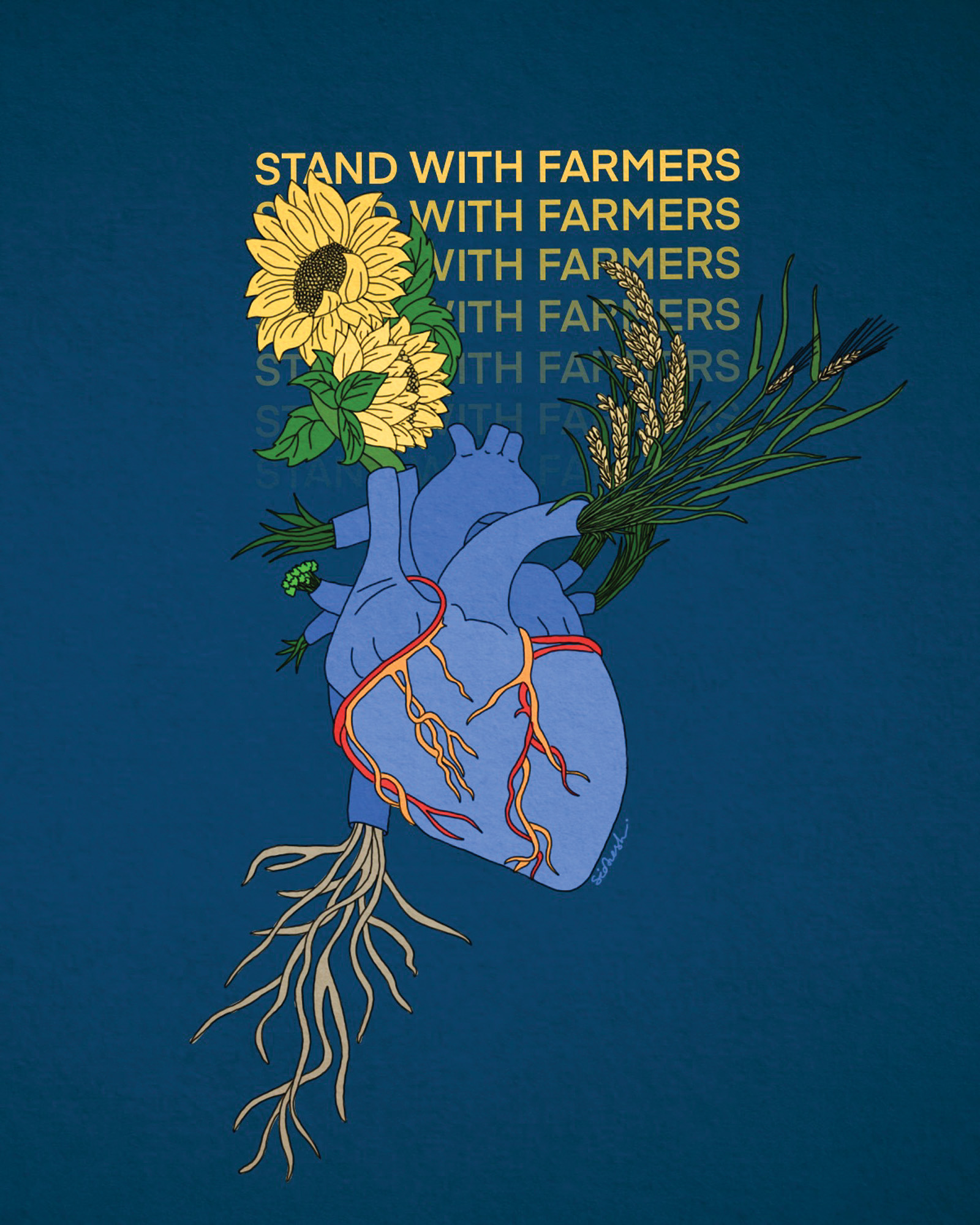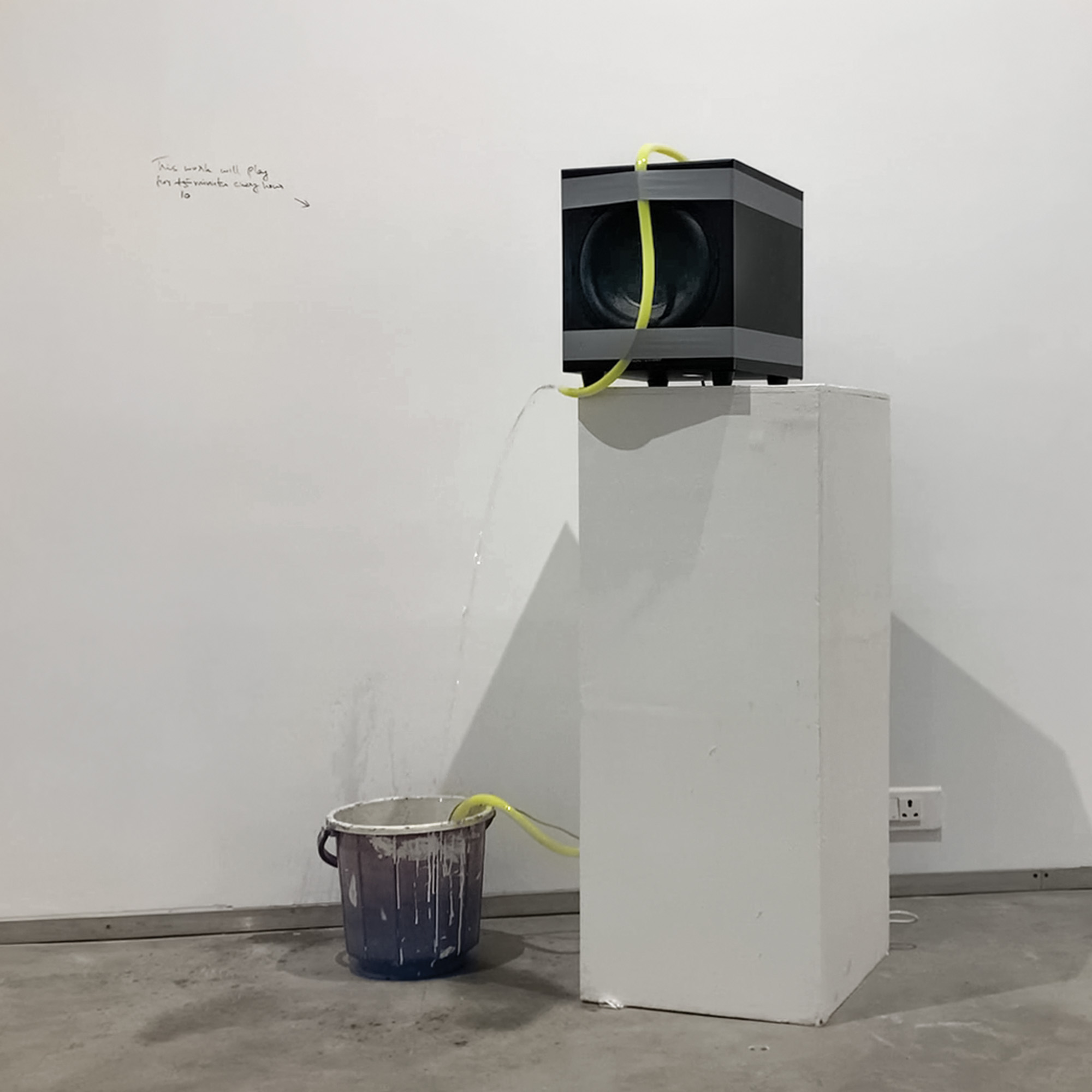New Delhi: An Interview with Sohrab Hura
By Pamela Wong
Full text also available in Chinese.

SIDDHESH GAUTAM, Stand with Farmers, 2021, digital art, 10.16 × 12.7 cm. Courtesy the artist.
Sohrab Hura is an artist whose work lies at the intersection of film, photography, sound, and text. Through his experimentations with form, his works question a constantly shifting world and his own place within it. In this interview, he recounts the ideas and events that moved New Delhi in 2021.
What happened in the art scene in New Delhi in 2021?
The pandemic’s second wave was quite devastating. It’s been a hard time for many artists, photographers, writers, as well as freelancers, so there have been lots of grants and support groups. Artists are moving out of Delhi, to the mountains or the sea. People want to live a healthier life and they are shifting to quieter places. For instance, the artist Malini Kochupillai, who publishes Khirkee Voice, a local newspaper in a small urban village in Delhi, has moved to the hills and helped the communities there with bee farming.
We went through a phase where almost every day we heard about someone we knew dying. We experienced helplessness, knowing that we were abandoned, and social media was the only thing that kept us in touch with the world. It was a very heightened state of awareness and vulnerability.
Today, there is no Delhi scene as such, because people have been active primarily online. For example, my gallery in Kolkata, Experimenter, ran its Curators’ Hub online this year. The nonprofit Khoj has created support groups in the last couple of years, and those also went online. A lot of collaborations are happening across India and new pan-India collectives are being formed online. There’s an all-women photographer collective called Eight Thirty, formed just six months ago, and not everyone has met each other in person. Those are the new relationships and ecosystems that I see emerging.
What were some of the conversations in 2021?
People are not just dealing with the pandemic but also the government, so the biggest events happened in social spaces instead of art spaces. We are having the largest farmers’ protest in history. After the Black Lives Matter movement, there’s also been a revival of conversations around caste and the idea of privilege within India itself. Caste wasn’t being fully acknowledged for a long time. We have many different hierarchies benefiting from many years of privilege and exploitations. Even art comes from the privilege of caste, class, region, city, and language. People are questioning these elements within the very hierarchical spaces of art and there is something in flux right now.
Artists who are working around the farmers’ protest are not really included in this art system at the moment. A lot of younger voices emerged in 2021, such as visual designer Siddhesh Gautam, who runs the handle @bakeryprasad; Rahee Punyashloka (@artedkar), a student and illustrator from Jawaharlal Nehru University; and Vibhu Grover, a young photojournalist who provided constant coverage about the protest while the mainstream media had ignored it.
They are taking important positions, while the art scene remains relatively quiet, because they have too much at stake to lose. For me, this is the highlight of the last year—there is no separation between the art world and real life. Because of Covid and the political climate, the barriers have been broken down and there’s no choice but to respond to these urgencies.

SOHRAB HURA’s map of interconnectedness for "Growing Like a Tree," Ishara Art Foundation, Dubai, 2021. Courtesy the artist.
How did the exhibition that you curated, “Growing Like a Tree,” at the Ishara Art Foundation in Dubai, come together?
When I was first asked to look at the visual history of the region, what was important to me was to ask, “what is South Asia?” I don’t even know what it means to be Indian, because my mother is from Dhaka and my father is from Lahore, so my own history has been stuck in the middle of these two larger histories. I was very aware that the history of image-making is somehow dominated by old White men, and I had been questioning that for a while. I can only question these ideas of geographical boundaries in Dubai. It is more complicated to do it in India, because we are living in so much noise around Indian, Pakistani, and Bangladeshi politics. This show is about unfixing histories, rather than fixing yet another history.
“Growing Like a Tree: Static in the Air” opened in September. How was it different from the show’s first edition?
Instead of extending the show, why not build on these ideas that we already had? I remember as a kid, I loved turning the knob on the radio and listening to the static in the air. Like the act of turning the knob, we brought about transformations every day for six days. We ended up pulling in clusters of artists to talk about things and ideas that are central to the exhibition. For example, on day one, Jaisingh Nageswaran’s work, which looks at the history of caste struggle, faded out; Zainab, a young photographer from Kashmir, slipped into Jaisingh’s space in the older cluster.

SOHRAB HURA, Untitled I, 2020, subwoofer, water, gaffer tape, hose, monopod/tripod, sound, submersible water pump, glass, camera, and bucket, dimensions variable. Courtesy the artist and Experimenter, Kolkata.
What were you thinking about in your own solo show, “Spill,” which traveled from Experimenter to Huis Marseille museum in Amsterdam?
In photography there is this burden of fixing and of representation. “Spill” for me is about this process of ricocheting between myself and the outside world, and my relationship with photography. In the exhibition, there is a bucket in this untitled sound installation, where I’m questioning how we look at screens as a place of reality. I generated these tones—sound frequencies of frames per second, which the screen is recording, so the water looks like it’s falling down or flowing up at times as I play with the tones. Within all of this, the water is spilling out of the bucket. The bucket, to me, is photography and images; and the water splashing out are the echoes and connections that lie outside of the medium.
How does the future look to you?
This period has made me think more practically than before, and what’s been on my mind is a constant reality check of hoping people around me are okay. What gives me hope, for example, are the students. It was a remarkable moment to see the amount of resistance that came forth. More and more people are looking past false promises.
.jpg)







